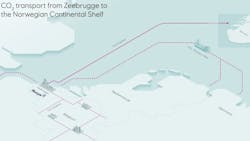Offshore staff
STAVANGER, Norway — Equinor and Belgian energy infrastructure operator Fluxys have agreed to co-develop facilities for transporting captured CO2 from industrial sources storage sites beneath the North Sea.
Work on the project, which would connect Belgium to Norway, is in the feasibility stage, with an investment decision anticipated by 2025.
Fluxys, via its associated companies, operates globally 12,000 km of pipelines and LNG terminals with a combined regasification capacity of 29 Bcm/year.
Among its subsidiaries is Fluxys Belgium, which owns and operates infrastructure for gas transmission and storage and LNG terminaling in Belgium.
The new proposal includes a 1,000-km export trunkline operated by Equinor, transporting 20 MM metric tons to 40 MM metric tons per year of CO2 across the North Sea to the seabed storage site on the Norwegian Continental Shelf.
The offshore trunkline would connect in Zeebrugge, Belgium to onshore CO2 transmission infrastructure built and operated by Fluxys.
According to Equinor, emitters in Belgium and surrounding countries would have access to the transmission system, and liquefied CO2 shipped from neighboring hubs also could be connected to the Zeebrugge facility.
Plans include a branch of the pipeline to the port of Dunkirk in the far north of France, with further connections to other northwest European countries considered.
Equinor/Fluxys aim to develop the project to be ready for commissioning before the end of this decade.
06.29.2022
